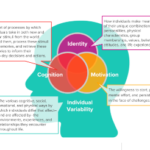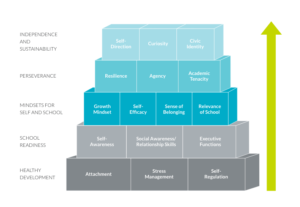
What is your shared understanding of how children and adults learn that guides your school culture, design, instruction, and assessment?
I’ve been developing a series of virtual seminars (ready to go by February 1st if you are interested) to help teams in districts and schools expedite the process of understanding of what it means to modernize our education system. I think if we get better at making the mind shift (paradigm shift) we won’t allow the beliefs of the traditional system corrupt implementation as much. (There will be other seminars developing on implementation later on in the year so stay tuned.).
In developing the first session of the seminar on the research on learning I pulled together six different frames that are available to help you think about creating your shared pedagogical principles.
- Designing for Learning: A Primer on Key Insights from the Science of learning and Development by Transcend
- Building Blocks for Learning
- 10 Cornerstones of Learning from Chpt 3 of Nature of Learning (OECD)
- The Nature of Learning: Using Research to Inspire Practice a Practitioner Guide from the Innovative Learning Environments Project (OECD)
- Nine Cognitive Principles from Why Don’t Students Like School? by Daniel Willingham
- Cornerstones of the Learning Sciences (CompetencyWorks)
Check out Designing for Learning by Transcend. It’s the most recent and has a tool that you can use in your school. Building Blocks for Learnign is the most comprehensive. Each summary of the research on learning emphasize points differently. Some are more focused on the learner, and some on what it means to support learning. Some focus on cognitive research, some on psychological and development, and some on both. Practitioners have the challenging job, and I’d say much tougher job, of integrating this research as it applies to instruction, assessment, and individual interventions. (I highly recommend reading this article by Amelia Peterson explaining two camps in the science of learning. Once you understand this, it’s a lot easier to be more selective about resources.)
How might you develop a shared understanding of learning (i.e., shared pedagogical principles)? Here is a suggested exercise: Have participants in a team select ten different principles from among all those listed below that they think will best strengthen your learning and teaching in your district or school. Cluster them to see where there are commonalities and differences. Ask which big concepts are missing and why. What would be the impact if you didn’t emphasize them? Narrow down to a list of no more than fifteen core principles to guide design and daily practice.
Designing for Learning: A Primer on Key Insights from the Science of Learning and Development by Transcend
Cognition
#1 Focused Attention: People learn best when they direct their focus toward the content and experiences most relevant to learning.
#2 Manageable Cognitive Load: People learn best when they are challenged but are processing a manageable amount in their working memory.
#3 Meaningful Encoding: People learn best when new learning is experienced in memorable ways and is related to prior knowledge.
#4 Effective Practice: People learn best when they practice challenging-but-doable skills at frequent, focused intervals across diverse contexts.
#5 High Quality Feedback: People learn best when they receive timely and targeted feedback to guide their improvement.
#6 Metacognitive Thinking: People learn best when they are able to plan, observe, evaluate, and adjust their own learning processes.
Motivation
#7 Value: People learn best when they find the content, outcomes, processes, and relationships associated with learning important and relevant.
#8 Self-Efficacy: People learn best when they believe in their ability to grow and achieve mastery of what they are learning.
#9 Sense of Control: People learn best when they perceive that they have meaningful and appropriate agency over their learning.
#10 Constructive Emotions: People learn best when they are in constructive emotional states versus feeling excessive stress or anxiety.
Identity
#11 Self-Understanding: People learn best when they have a deep understanding of who they are and can use this knowledge to maximize their learning.
#12 Self of Belonging: People learn best when they feel connected to, and accepted by, the people and environment around them.
#13 Navigating Identity Threats: People learn best when negative beliefs associated with their identity are minimized or buffered against.
Individual Variability.
#14 Life Experiences: People learn best when their unique life advantages and adversities are understood and responded to.
#15 Developmental State: People learn best when their experiences align with where they are developmentally.
#16 Learning Differences: People learn best when their unique learning needs are identified and resources and supports are aligned with these needs.
Building Blocks for Learning
Turnaround for Children developed Building Blocks for Learning to support the development of children that have endured trauma. The five categories of skills and mindsets are applicable to all children. However, they may require more intentional strategies to be developed for those children who are more vulnerable. The Building Blocks for Learning are based on two papers summarizing research. They are challenging reports but well worth reading.
- Malleability, plasticity, and individuality: How children learn and develop in context and
- Drivers of human development: How relationships and context shape learning and development.
Below are five of the major findings from the report about child development and learning.
 Human development depends upon the ongoing, reciprocal relations between individuals’ genetics, biology, relationships, and cultural and contextual influences.
Human development depends upon the ongoing, reciprocal relations between individuals’ genetics, biology, relationships, and cultural and contextual influences.- Each individual’s development is a dynamic progression over time.
- The human relationship is a primary process through which biological and contextual factors mutually reinforce each other.
- All children are vulnerable. In addition to risks and adversities, micro- and macro-ecologies provide assets that foster resilience and accelerate healthy development and learning.
- Students are active agents in their own learning, with multiple neural, relational, experiential, and contextual processes converging to produce their unique developmental range and performance. This holistic, dynamic understanding of learning has important implications for the design of personalized teaching and learning environments that can support the development of the whole child.
Edutopia and Turnaround for Children have developed a video series about the implications of the Building Blocks for Learning for teaching.
10 Cornerstones of Learning from Chapter 3 of Nature of Learning (OECD)
- Learning is an activity carried out by the learner.
- Optimal learning takes prior knowledge into account.
- Learning requires the integration of knowledge structures.
- Optimally, learning balances the acquisition of concepts, skills, and meta-cognitive competence.
- Learning optimally builds up complex knowledge structures by organizing more basic pieces of knowledge in a hierarchical way.
- Optimally, learning can utilize structures in the external world for organizing knowledge structures in the mind. It all starts with explicit learning goals.
- Learning is constrained by capacity limitations of the human information-processing architecture.
- Learning results from a dynamic interplay of emotion, motivation, and cognition.
- Optimal learning builds up transferable knowledge structures.
- Learning requires time and effort.
The Nature of Learning: Using Research to Inspire Practice a Practitioner Guide from the Innovative Learning Environments Project (OECD)
The principles are identified as:
- The learning environment recognizes the learners as its core participants, encourages their active engagement, and develops in them an understanding of their own activity as learners.
- The learning environment is founded on the social nature of learning and actively encourages well-organised cooperative learning.
- The learning professionals within the learning environment are highly attuned to the learners’ motivations and the key role of emotions in achievement.
- The learning environment is acutely sensitive to the individual differences among the learners in it, including their prior knowledge.
- The learning environment devises programs that demand hard work and challenge from all but without excessive overload.
- The learning environment operates with clarity of expectations using assessment strategies consistent with these expectations; there is a strong emphasis on formative feedback to support learning.
- The learning environment strongly promotes “horizontal connectedness” across areas of knowledge and subjects as well as to the community and the wider world.
Nine Cognitive Principles from Why Don’t Students Like School? by Daniel Willingham
- People are naturally curious, but we are not naturally good thinkers; unless the cognitive conditions are right, we will avoid thinking.
- Factual knowledge must proceed skill.
- Memory is the residue of thought.
- We understand new things in the context of things we already know, and most of what we know is concrete.
- It is virtually impossible to become proficient at a mental task without extended practice.
- Cognition early in training is fundamentally different from cognition late in training.
- Children are more alike than different in terms of how they think and learn.
- Children do differ in intelligence, but intelligence can be changed through sustained hard work.
- Teaching, like any complex cognitive skill, must be practice to be improved.
Cornerstones of the Learning Sciences (CompetencyWorks)
The ten cornerstones were developed through a collaborative process with researchers and practitioners sharing their ideas about how to best communicate a set of pedagogical principles that were published in the paper Levers and Logic Models.
- Learning is an activity that is carried out by the learner.
- Learning results from the interplay of cognition, emotion and motivation.
- Learning does not occur through a fixed progression of age-related stages. The mastery of new concepts happens in fits and starts.
- Intrinsic motivation leads to better long-term outcomes than extrinsic motivation.
- Effort is dependent on motivation and self-regulation.
- Learning is shaped by the way information is processed and transferred into long-term memory.
- Learning builds on prior knowledge and context.
- Acquiring new knowledge and skills requires effective feedback.
- Learning is a social process.
- Learning occurs through interaction with one’s environment.



One response to “Laying the Groundwork: Shared Understanding of How Children Learn (Part 2)”